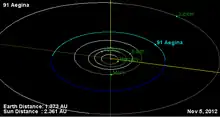91 Aegina
Aegina (from Latin Aegīna, Aegīnēta),[4] minor planet designation 91 Aegina, is a large main-belt asteroid. It was discovered by a French astronomer Édouard Jean-Marie Stephan on 4 November 1866. It was his second and final asteroid discovery. The first was 89 Julia. The asteroid's name comes from Aegina, a Greek mythological figure associated with the island of the same name.
 Orbital diagram | |
| Discovery | |
|---|---|
| Discovered by | Édouard Stephan |
| Discovery date | 4 November 1866 |
| Designations | |
| (91) Aegina | |
| Pronunciation | /ɪˈdʒaɪnə/[1] |
Named after | Aegina |
| Main belt | |
| Adjectives | Aeginetan /iːdʒɪˈniːtən/[2] |
| Orbital characteristics | |
| Epoch 31 December 2006 (JD 2454100.5) | |
| Aphelion | 428.453 Gm (2.864 AU) |
| Perihelion | 346.826 Gm (2.318 AU) |
| 387.640 Gm (2.591 AU) | |
| Eccentricity | 0.105 |
| 1,523.536 d (4.171 yr) | |
Average orbital speed | 18.45 km/s |
| 183.458° | |
| Inclination | 2.109° |
| 10.806° | |
| 73.371° | |
| Physical characteristics | |
| Dimensions | 109.8 km |
| Mass | 1.4×1018 kg |
Equatorial surface gravity | 0.0307 m/s² |
Equatorial escape velocity | 0.0580 km/s |
| 6.03 hours | |
| 0.043 [3] | |
| C | |
| 8.84 | |
This body is orbiting the Sun with a period of 4.17 years and an eccentricity of 0.105. The orbit of this object brings it to within 4.9 Gm of the dwarf planet Ceres, and the resulting gravitational interaction has been used to produce mass estimates of the latter.[5] The cross-section size of the asteroid is 110 km and it has a rotation period of six hours. The surface coloring of 91 Aegina is very dark and this C-type asteroid has probably a primitive carbonaceous composition. Observation of absorption bands at wavelengths of 0.7 and 3μm indicate the presence of hydrated minerals and/or ice grains on the surface.[6]
References
- Noah Webster (1884) A Practical Dictionary of the English Language
- Figueira (1981) Aegina, society and politics
- Asteroid Data Sets Archived 17 December 2009 at the Wayback Machine
- Charlton T. Lewis, Charles Short, A Latin Dictionary
- Viateau, B.; Rapaport, M. (June 1998). "The mass of (1) Ceres from its gravitational perturbations on the orbits of 9 asteroids". Astronomy and Astrophysics. 334: 729–735. Bibcode:1998A&A...334..729V.
- Howell, E. S.; et al. (October 2011). Hydrated silicates on main-belt asteroids: Correlation of the 0.7- and 3 micron absorption bands (PDF). EPSC-DPS Joint Meeting 2011, held 2-7 October 2011 in Nantes, France. p. 637. Bibcode:2011epsc.conf..637H. Retrieved 22 November 2020.
{{cite conference}}: CS1 maint: multiple names: authors list (link)
External links
- Lightcurve plot of 91 Aegina, Palmer Divide Observatory, B. D. Warner (2009)
- Asteroid Lightcurve Database (LCDB), query form (info Archived 16 December 2017 at the Wayback Machine)
- Dictionary of Minor Planet Names, Google books
- Asteroids and comets rotation curves, CdR – Observatoire de Genève, Raoul Behrend
- Discovery Circumstances: Numbered Minor Planets (1)-(5000) – Minor Planet Center
- 91 Aegina at AstDyS-2, Asteroids—Dynamic Site
- 91 Aegina at the JPL Small-Body Database